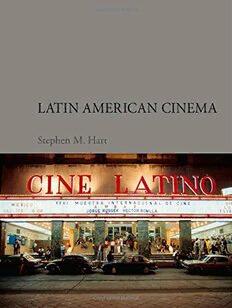
Latin American cinema PDF
Preview Latin American cinema
Latin American Cinema Latin American Cinema Stephen M. Hart reaktion books For Dany Published by Reaktion Books Ltd 33 Great Sutton Street London ec1v 0dx, uk www.reaktionbooks.co.uk First published 2015 Copyright © Stephen M. Hart 2015 All rights reserved No part of this publication may be reproduced, stored in a retrieval system, or transmitted, in any form or by any means, electronic, mechanical, photocopying, recording or otherwise, without the prior permission of the publishers Printed and bound in China A catalogue record for this book is available from the British Library isbn 978 1 78023 365 9 Contents Introduction 1 Inauspicious Beginnings (1895–1950) 2 Nuevo Cine Latinoamericano and the ‘Time-image’ (1951–1975) 3 Nation-image (1976–1999) 4 The Slick Grit of Contemporary Latin American Cinema (2000–2014) References Select Directors’ Biographies Select Bibliography Acknowledgements photo acknowledgements Index Introduction This book grew out of a hunch – highlighted by my experience teaching documentary filmmaking at summer schools held at the Escuela Internacional de Cine y Televisión in San Antonio de los Baños in Cuba since 2006– that Latin American film has as much to do with the step- changes in film technology as it does with the historical and political reality it memorializes. Or, to put it another way, that film historians have to be as sensitive to the implications of major paradigm shifts which have occurred in camera technology – such as the use of the hand-held camera in the 1950s or the emergence of digital film at the end of the 1990s – as they are alert to the major historical changes that occurred in Latin America in the twentieth century (such as the rise of dictatorship in the 1970s and 1980s, and the radical political polarizations that took place as a result in the political space of a number of Latin American nations). This hunch was partly based on Lev Kuleshov’s argument that the best type of approach to film is one that blends theory with practice. As Kuleshov suggests, teaching film craft ‘without being cognisant of funda- mental cinematic theories demeans film craft to the mere level of an amateur workshop. Likewise, studying film history and theory without a corresponding experience in the elemental aspects of filmmaking leaves theoretical research without a solid basis, forcing students to plunge into abstraction.’¹This book extends Kuleshov’s thesis by arguing, for example, that to ignore the evolving technology by which, at a given time and in a given place, the image was captured, edited and produced is to run the risk of producing ‘timeless’ and ‘static’ interpretations of films. This basic insight has been used in this book as a key to reassess the ways in which we think about the evolution of film as a discursive, investigative and imagistic medium. Occasionally film historians look at the history of film as if it were a sideshow appended to the grand narrative of nations having wars with each other, and thus produce chapters entitled, by way of example, ‘Post-World WariiFilm’. While, in some isolated cases, film may have coincided with enormous upheavals in history, in many others it did not. Film, indeed, has its own history. Thus the creation of cross-cutting by D. W. Griffith in his film A Corner in Wheat(1909), such that the wealth of the upper classes is contrasted with the poverty of the lower classes, was arguably just as important for the evolution of film as the brutal historical sequence of the First World War. Likewise the hand-held camera in the 35mm Canadian film Les Raquetteurs(‘The Snowshoers’, directed by Michel Brault and Gilles Groulx) which was used to film the convention of snowshoers held in Sherbrooke, Quebec, in February 1958, demonstrated the new flexibility of the camera to mingle in with the public, almost as if it were another spectator within the crowd that had gathered to witness the events. Filming with a hand-held camera was an innovation destined to have far-reaching consequences for the way in which filmmakers subsequently saw their craft. It radically democratized film, allowing for the creation of a living, ‘breathing’ camera. The advent of digital film 30years later – Idioterne(‘The Idiots’, 1998), directed by Dogme 95Danish film director Lars von Trier, was the first film to be filmed entirely on a digital camera (a Sony dcr-vx1000) – led to one of the most radical changes ever experienced in the film industry. The digital camera in the new millennium, given its flexibility, low costs, portability and the fact that you can see immediately what you are recording, offered the opportunity for thousands to create new narratives about the world we live in. It signalled the birth of a post-35mm universe which eschewed the grand narrative of national destiny or world wars, focusing instead on the everyday lives of the world’s citizens. It also introduced a new vision of the world. Since the digital camera never ‘cuts’ the film in the way the analogue film editor did, it allows the universe to be seen as an unbroken continuum. This continuum is perceived not only through time but also through space. Thus the traditional tripartite division of filmic space (foreground, mid-ground, background), which is itself based on a theatrical paradigm, no longer holds in the digital | latin american cinema
